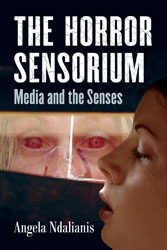Of all screen genres, Horror has perhaps stimulated the most scholarship, with various attempts to explain its social and psychological meanings and functions, and the paradoxical pleasures for its audiences of something that can be almost unbearable to watch. Angela Ndalianis’s The Horror Sensorium: Media and the Senses is a most welcome contribution. In fact it may be one of the most persuasive and useful approaches yet, both in terms of the way it conceptualises our engagement with horror, but also in how it expands out from cinema to a range of media forms such as video games, paranormal romance novels, television, and theme park rides, which, as she acknowledges, have both economic and aesthetic links in an era of horizontally integrated entertainment conglomerates.
Partly informed by the recent phenomenological turn in film studies characterised by the work of Vivian Sobchack, Jennifer Barker and Tarja Laine, Ndalianis argues that our experiences of horror media cannot be explained by purely haptic, affective or cognitive theories alone, but that all of these things work together. Her key concept is “The Sensorium”, an “integrated unit that combines cognition and the senses, the mind and the body.” (16) This is the means through which we perceive, feel and make sense of our environment.
The book’s chapters examine the importance of the sensorium to our experience of horror in different media forms, and how films, novels, television and videogames use the different means at their disposal to work on our senses. But lest you think this is all just centred on the primal emotions and responses like disgust, anticipatory anxiety, desire and the startle reflex, the final three chapters move the emphasis onto cognitive appeals. While still acknowledging the senses, Ndalianis focuses on the pleasures of intellectual games such as the intricate reflexive genre play of Tarantino and Rodriguez’s Grindhouse (2007), the puzzle narratives and transmedial storytelling of JJ Abram’s Cloverfield (2008) and Lost (2004-2010), and the entanglement of reality and fiction in viral marketing for horror film and TV.
It’s all good, but I especially liked the chapter on New Horror for its comparison of the sensory aesthetic distinctions between the 1977 and much gorier 2006 version of The Hills Have Eyes. Ndalianis argues that the latter film contains a stronger social critique than its predecessor that, in its unremitting focus on the bubbling texture of disgusting fleshy mutations, savage eviscerations and explosions, viscous blood, splintering bone and pulped brain matter are experienced through our cringing disgusted bodies. Her point is that the underlying survival logic of disgust is, in New Horror, mapped onto the ideological issues of these films, rather than serving just as revolting stimulus to jolt a jaded horror viewer.
Horror is used as the gore-dripping connective fibre between the chapters, but is not the sole focus. Rather, the chapters become launchpads for excursions into fascinating and informative media histories, theories of audience-text relations, and colourful informal anecdotes of Ndalianis’s own personal encounters with films, videogames, novels, TV, viral marketing, and immersive entertainments. Like Vivian Sobchack, she throws her whole body into the work, so it at times becomes a fleshy confessional of crawling skin, sensuously quivering insides, tense limbs, shrieks, groans and adrenaline-charged hammering hearts. But at the same time, we are privy to the games and playful puzzle solving processes of her mind in these encounters. Both help to bring alive for the reader the complex nature of our ‘interface’ with texts that, in the case of those belonging to the horror genre especially, solicit cognitive, corporeal and sensorial responses from us, inviting play, evaluation, repulsion, anxiety but also laughter.
There is much else that is useful. The chapter on Video Game Horror and Doom 3, with its rich attention to the ways games since Doom have remediated horror cinema and other forms of media such as graphic novels within the spatial structures and audio-visual textures of their dynamic worlds, will be a valuable addition to the reading lists of courses in the burgeoning area of Adaptation studies. The chapter on paranormal romance novels and TV is interesting reading if you’ve ever wanted to understand what happens when sex meets horror, and desire mingles with disgust. After expounding on the popularity of the vampire as an alpha male romantic hero, and the different forms he can take, Ndalianis illustrates the appeal of sexy vampires by showing what happens if you replace the vampire with his living dead cousin, the zombie (the book was written before Warm Bodies came to popular attention). She rewrites a passionate thrusting and quivering sex and biting scene between a most willing woman and her vampire lover, replacing the vampire with a rutting flesh-eating zombie, whose body rots under his unwilling victim’s defensive pushes and gouging fingers. It is undeniably and hilariously gross. Reading it, I was laughing but also practically gagging as my own sensorium conjured the sickly fumes and unctuous textures of old meat – testament to Ndalianis’ considerable skill as a writer.
Perhaps though The Horror Sensorium’s greatest significance lies in how the lines of inquiry that animate its pages repeatedly connect in thought-provoking ways to fundamental questions of why and how we respond to any fictional text as if it were real. Finally: one of my Honours students borrowed my review copy as soon as it hit my pigeon-hole and absolutely loved it. When I got it back it had been populated with a forest of post-it notes, proof, I think, of just how accessible this book will be to film scholars of all levels.

